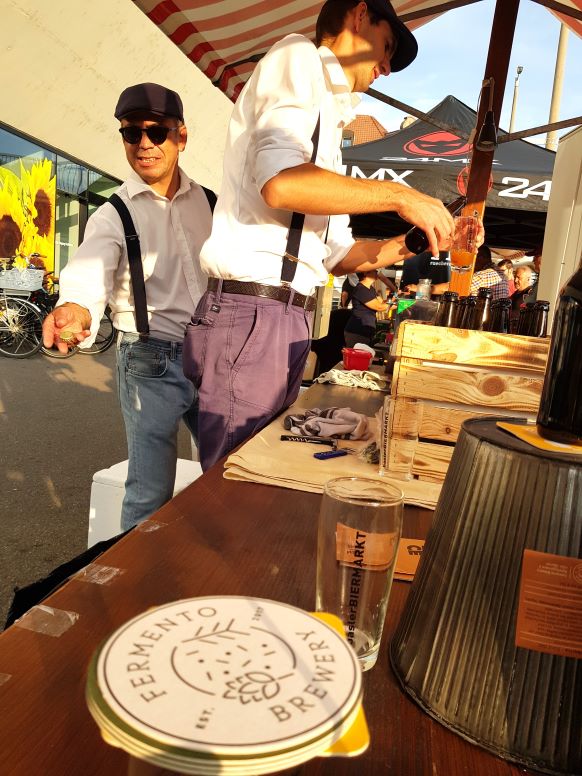
There comes that moment in life when you are faced with a craft beer for the first time.
Either a friend offers you one, or you happen to attend a craft beer festival, or a bartender proposes you some craft beer options to choose from the drinks list.
Intrigued and perhaps confused, you decide to give it a try and choose
a craft beer. You sip it and, after a refreshing sensation,
you feel an explosion of flavor! Flavours such as cocoa, coffee,
liquorice, fruit, bread, floral and resinous aromas, etc. are common to different beer styles.
My first experience with craft beer was with an Irish friend. He was always in the mood for
a beer and of course, stout was his first choice. What a
taste that beer had! Being Italian and Swiss, coffee and
chocolate are obviously among my favourite tastes, and it was surprising
to find them in that Irish beer, knowing that neither chocolate nor
coffee had been used, but roasted malts.
From that stout, I approached the world of craft beer, explored beer styles, and found my favourite tastes and the beers I loved the most. Since then, it has been quite a journey and I would like to share the experiences I have had that led me to choose my craft beer.
These are my 4 guiding principles for navigating the sea of beer and that will help you to choose the craft beer you really love.

Taste first. To choose your craft beer, focus on what you like
Knowing your own taste is fundamental. No one can tell you what you like and what you don’t. Human taste can be traced back to the five basic tastes: sweet, sour, bitter, salty, and umami. It is normal to have a personal preference for one or more of these.
There are stereotypes one can read about taste preferences. For example, I have heard that a woman would never appreciate the bitter taste of an IPA. Apparently, women have a greater sensitivity to bitterness than men, so they would find this style of beer too bitter and overpowering.
According to some studies, in prehistoric times it was the duty of women to taste food, to make sure it was safe, before giving it to their children. Since poisoned food tasted bitter, women were able to tell if it was suitable for family consumption or if it contained poison, even in small quantities.
This is a very interesting theory, however, in my experience, there is nothing more wrong than to deduct, as some do, that all women do not like bitter beers. Many, in fact, do like IPAs!
I love organising beer tastings, talking to people and discovering their best tastes together. When someone approaches me and wants to choose craft beer for the first time, man or woman, young adult or mature, I always ask the same question: What kind of taste do you like? And if the question is too vague, another, slightly more specific one follows: Sweet and malty or bitter and hoppy? Fruity or floral? And so on…
Ask yourself these questions. The answer will tell you what you like, your favourite tastes and, consequently, the styles of beer you would enjoy most. These are most likely the beers you would choose to drink.
MALTY AMBER, LAMBIC, BALTIC STOUT, DUBBEL, QUADRUPEL
PILSNER (mild), IPA, APA (strong)
SAUER BEER
WHEAT BEER (Banana), HAZY IPA, NEW ENGLAND IPA (bitter-fruity), LAMBIC (sour-fruity)
DUNKELBIER

To choose your craft beer, ask for advice
Beer festivals and tastings are a fantastic opportunity to try new beers. Don’t be afraid and ask for a sip! It is the brewer’s duty to share a beer sample and give you the best, unbiased advice for choosing your craft beer.
Things are different if you are in a supermarket or beer shop and want to choose your craft beer. Craft beer bottles are usually in a dedicated section, separate from industrial beers.
My advice is not to base your choice only on the label of the beer bottle (as unfortunately many do). Labels are always very beautiful and colourful to attract your attention, but a good, shiny label does not always mean a good beer. However, labels are an excellent means of communicating the brewery’s brand and what it stands for.
Before buying a craft beer, I recommend you seek advice. This could be a good friend who is an expert on beers. A useful idea would also be to read reviews about the brewery and its beers. Consult, for instance, Google reviews or the ratings of specialised beer apps. However, keep in mind that all these comments and reviews express a personal opinion. Taste is very subjective, as is the way of communicating opinions. Sometimes people are diplomatic, sometimes indecisive or very emotional.
Some beers have been awarded prizes in competitions. Contests certify that beers have undergone a blind tasting test. This means that qualified professionals taste the beers without knowing their names but only the style of beer to which they belong. Each beer is evaluated according to quality and taste parameters.

The scores are then compared during the competition and the beers with the best scores are awarded. In professional competitions, reviews and scores are impartial and follow a standardised evaluation. Focusing on award-winning beers and reading scores and reviews can be very helpful in supporting your decision to choose craft beer. However, often the language used in reviews of these competitions can be very technical and confusing for craft beer beginners.
However, by reading the Fermento Beer Blog, you will get to know the world of craft beer better and better.
Know who is “behind” the brewery
Come and meet the brewer. Is he/she a professional? Find out who is behind the brewery and their career path.
Most brewers have a real passion for their product and a ‘philosophy’ behind their brewery. Many brewers start in the kitchen at home, brewing beers with a friend. This is a great way to begin. However, brewing is a science and requires the development of skills and knowledge about ingredients, microbiology, production techniques, etc. Knowledge and experience in brewing makes the difference between producing an excellent craft beer and a standard beer.
To get to know the brewers personally, the best thing is to attend beer festivals and shake their hands. It is exciting to have a chat with the person who brewed your beer. Talking to the brewer will give you a good impression of his passion, his knowledge and what his brewery stands for.
Try to capture what I would call the ‘soul’ of the brewery. For example, we at Fermento brew Swiss beer with Italian heart. We bring with us Swiss precision, science, and Italian passion for life and good taste. We also believe that great beers deserve great food, which is why we appreciate our beers paired with delicious (and junk-free) food.
You capture the soul of the brewery from everything you see, from the brewery website, social media profiles, stands at beer festivals and beer labels. Is the message you receive from the brewery consistent and unique to you? Do you recognise yourself in that message? Then this is your brewery!

Last but not least. Drink and enjoy!
The last and best advice I can give is to go for it. Drink it and enjoy it!
To choose your craft beer, I recommend simplifying the tasting rules to a few to make sure you taste it in the best conditions, so as not to be influenced by other factors that might affect your taste perception. Of course, these tips are not to be applied every time you have a drink.
Make sure you have not smoked. Avoid eating food that is too spicy, strong-tasting or greasy for at least 30 minutes. Do not drink coffee or other alcoholic beverages such as spirits, cocktails or wine. When tasting different beers, start with light (Pilsner and wheat beers) and then move on to the stronger ones (amber ales and stouts) before drinking the IPAs, which should be left at the end.
Choose a beer glass for degustation, preferably the Teku glass. However, if not available, use a white wine glass for light beers and a red wine glass for stronger beers. This will do. A good beer can already be smelled in the nose. If the glass is half full of beer, swirl it very gently before smelling it.
The first sip is the most refreshing. That is where the first impression is made. Then take a second sip. This will be the moment when you begin to decide weather this is the beer for you. Don’t make it too complicated to formulate your beer evaluation. This is not a sommelier masterclass. Do you like it and why (or why not)? When I drank my Irish Stout for example, I liked the chocolate, coffee and light roast flavour. I liked its dry taste, while I did not like the caramel and sweet taste of other stouts.
You could describe your beers in more or less words, but what really matters is that you enjoy them, and they make you happy. . And when you repeat great tasting experiences with other craft beers, and I am sure you will, you will most likely end up thanking the friend who gave you that craft beer for the first time, as I still do.

From choosing your craft beer to brewing one
I followed these four guiding principles and found my own way to choose my craft beer, and I have found it! What is my favourite beer? It is the one I brew.
After tasting and drinking craft beers for a few years, I found the taste I really like and decided to brew it myself. I like and brew craft beers that are balanced, where I find the taste of all ingredients. Taste of chocolate and coffee gently prevail in my stout, fruits in my wheat beer and floral taste in my honey beer. This is my beer “philosophy” and the craft beers I love to brew!
There comes a time when your passion for beer indeed takes you to the next level: from choosing a craft beer to brewing your own. But that’s another story….